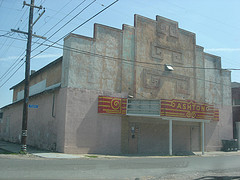
NorthWest Carrollton would like to work to have this building added to the National Historic Register. In addition to being one of the last old theatres in New Orleans, it was designed by Ferdinand Lucien Rousseve (1904–1965).
In April 1934 he sat for and passed the state licensing examination for architects, becoming the first licensed Black architect in Louisiana.
We are in contact with some of Rousseve's relatives that remain in the New Orleans Area.
The Ashton is currently owned by the artist Lin Emory but is not open ot the public.
The websites below that provided this research are no longer working but this detail is some of the information that has been sent to NorthWest Carrollton on the Ashton Theatre.
__________________________________________________________________
/http://www.bookrags.com/tandf/ferdinand-lucien-rousseve-tf/
Ferdinand Lucien Rousseve (1904–1965)
John J.Burns Library,
Ferdinand
Rousseve was born on July 18,1904, in New
Orleans , Louisiana
Ferdinand’s
father enrolled him in Saint Louis Elementary, a private school in New Orleans,
and then successive New Orleans parochial schools—Holy Family Boys’ Middle School and Xavier Preparatory High School.
Ferdinand Rousseve was inspired to study architecture by his Xavier drafting
and industrial arts teacher, William Lewis. He graduated with academic honors
third in his class in June 1922.
Rousseve was a
smart and determined student who advanced his station in life by seeking out
and conquering the educational opportunities that presented themselves to him.
Following his graduation from high school, he enrolled at Guillaume
College in New Orleans Engineering School in Chicago ,
Illinois New Orleans Cambridge , Massachusetts Rindge
Technical High
School in Cambridge Cambridge Boston
Greater Tulane Baptist
Church
1929 he worked
as a draftsman for the nonprofit Architectural Bureau of the Young Men’s
Christian Association in
Not since
ROBERT ROBINSON TAYLOR in 1892 had the Massachusetts Institute of Technology
graduated a Black architect. Rousseve was a hot commodity and he quickly found
employment as an instructor in the School
of Architecture at HOWARD UNIVERSITY New York City
In April 1934
he sat for and passed the state licensing examination for architects, becoming
the first licensed Black architect in Louisiana
Rousseve added
a capital to his record of scholarship in 1948 when he was awarded a doctoral
degree in architecture from Harvard
University
Ferdinand
married Elise Mirault Clarke of When Rousseve returned to
Rousseve
designed many buildings in the Gulf region of Louisiana ,
Mississippi , Alabama ,
and Texas Tulane
Baptist Church
in New Orleans and St. Jude’s Catholic Hospital
in Montgomery , Alabama
Rousseve was quoted as saying, “I have a strong conviction that it is our individual and collective duty to make our communities better places in which to live.”3 His civic commitment was demonstrated by board memberships in the New Orleans Family Services Society and New Orleans Council of Social Agencies and in
In 1961
Rousseve returned to Massachusetts to accept
the directorship of the Fine Arts Department at Boston College Art Department at a predominately White college and being
one of the few architects to head an Art
Department
Ferdinand
Rousseve died on July 18, 1965, at Saint Elizabeth’s Hospital in Brighton , Massachusetts Newton Cemetery
in Newton Centre, Massachusetts
Notes
1. Louisiana State
2. Ferdinand
Rousseve, “The Majestas
Domini in the Tympanum of the Twelfth Century
French Church —A
Study in Iconography,” (master’s thesis, University of Chicago
3. Clarence
Laws, “Ferdinand L.Rousseve-Architect and Citizen,” Opportunity . (September 1947): 95.
4. “Dr.
Ferdinand Rousseve, B.C.Fine Arts Chairman,” Traveler (Boston
Bibliography
“Rousseve,
Ferdinand Lucien.” In Who Was Who in America New York
“Rousseve,
Ferdinand.” In Directory
of American Scholars. Lancaster ,
Pennsylvania
DRECK SPURLOCK WILSON
BUILDING LIST
Name
|
Address
|
City
|
State
|
Year
|
Comments
|
House
|
LA
|
||||
House
|
LA
|
||||
House
|
LA
|
||||
Twin House
|
LA
|
||||
5th
|
LA
|
Michael D’Orsi, assoc. architect
|
|||
Ashton Theatre
|
LA
|
Michael D’Orsi, assoc. architect
|
|||
LA
|
|||||
Central Congregational
|
LA
|
||||
Cherrie-Segue Medical Clinic
|
LA
|
Michael D’Orsi, assoc. architect
|
|||
Convents Holy Ghost Catholic Church
Rectory
|
LA
|
Addition
|
|||
LA
|
Destroyed by fire
|
||||
Greater
|
LA
|
||||
Le Rendezvous Restaurant
|
Michael D’Orsi, assoc. architect
|
||||
Campus
|
Baton Rogue
|
LA
|
Now Southern Univ. Archives Bldg.
|
||
McDonald Dental Office
|
LA
|
||||
People’s
|
LA
|
Michael D’Orsi, assoc. architect
|
|||
LA
|
|||||
LA
|
Michael D’Orsi, assoc. architect
|
||||
Rousseve, Ferdinand L.
|
MA
|
||||
St. Claver’s
|
LA
|
1921
|
Michael D’Orsi, assoc. architect
|
||
St. Jude’s
|
1951
|
Now Apts.
|
|||
St. Raymond’s Catholic Church
|
http://www.ohsno.org/opus_lists/index.htm
REPRODUCO
|
|||
Reproduco / Ashton Piano
|
Ashton
Theatre,
|
*The Organs of
the United States and Canada
This
page is a service of www.neworleanschurches.com
and theNew Orleans
and the
http://www.cinematour.com/picview.php?db=us&id=63805
http://www.preservationnation.org/travel-and-sites/sites/southern-region/ashton-theatre.html
http://www.preservationnation.org/travel-and-sites/sites/nationwide/historic-american-movie-theaters.html
2 comments:
Two corrections. My father Numa Rousseve painted landscapes, considered himself a professional portrait painter and taught art at Xavier University in New Orleans. When Ferdinand moved to Cambridge to start the art department at Holy Cross College in Worcester MA, my parents bought the house he designed at 4636 Willow St in New Orleans.
Charles Rousseve was a New Orleans public school educator and principal.
Faulty memory! Ferdinand returned to Massachusetts in 1948 to head up the art department at Boston College. (My niece is now VP in administration at Holy Cross College.)
Post a Comment